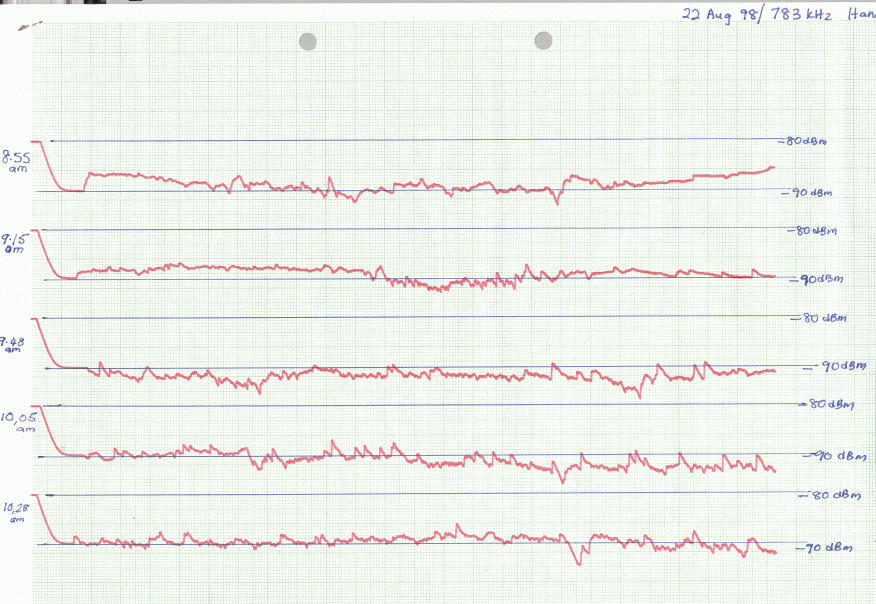Radio observation of the total solar eclipse of 22nd August 1998
May 2013. This page has been superceeded. Please visit the new version at : https://sites.google.com/site/randomwok/Home/amateur-radio-astronomy-1/radio-observation-of-22nd-august-1998-solar-eclipse
----------------------------------------
I. Direct observation at 408 MHz
Expecting solar RF radiation to be absorbed by the moon's mass during the eclipse, I set out to measure the solar radiation at 408 MHz. From my location in Bayan Lepas, Penang, Malaysia, an 83% obscuration is expected (fig. 1).
The measuring setup is very rudimentary - consisting of a "generic" UHF TV Yagi aerial, mast-head pre-amplifiers, spectrum analyzer and power meter (fig 2). The spectrum analyzer's settings are: 408MHz centre frequency, zero span mode and maximum (1MHz) IF bandwidth. At this combination of settings, the displayed noise floor is -90dBm - corresponding to a 24dB overall noise figure. The gain between the RF input and the IF output port is 51.7dB. The power is sampled at the spectrum analyzer IF output port using a power meter. Time-interval logging of the power meter readings was done using HP (now Agilent) Vee test automation software (thanks to CW Kong for programming!) running on a PC.
II. Indirect observation by measurement of ionospheric change at the Medium Wave band
I also investigated if low frequency radio-wave propagation was affected by the eclipse preventing solar radiation from reaching the earth's ionosphere. Using a consumer-grade car radio (Blaupunkt brand) and a long-wire aerial, I tuned to a foreign language station at 783 kHz on the Medium Wave (MW) band. According to the World Radio TV handbook, this transmission belonged to Radio Hanoi. Due to PC already being occupied with the 408 MHz monitoring, the 783 kHz reception strength data was logged using archaic strip chart recorder. The chart recorder plotted the "Received Signal Strength Indicator" (RSSI) voltage from the car radio's Intermediate Frequency IC (TDA4200) against time. However, no clear pattern indicative of the eclipse's influence on the ionosphere could be discerned in this experiment. Perhaps, this result is to expected given that solar radiation on the ionosphere has a long time lag.
This Williams College's site collects reports on this particular event from various (visual) observers worldwide.
----------------------------------------
I. Direct observation at 408 MHz
Expecting solar RF radiation to be absorbed by the moon's mass during the eclipse, I set out to measure the solar radiation at 408 MHz. From my location in Bayan Lepas, Penang, Malaysia, an 83% obscuration is expected (fig. 1).
 |
| Fig. 1 Time-table published by the Astronomy Club and the Astronomy section of the Science Museum, Universiti Sains Malaysia (USM) , Penang, Malaysia. Local time = GMT + 8H. |
 |
| Fig. 2 408MHz automated measuring setup |
 |
| Fig. 3 no-brand UHF Yagi aerial used in the 408MHz setup - gain and other characteristics unknown |
The measuring setup is very rudimentary - consisting of a "generic" UHF TV Yagi aerial, mast-head pre-amplifiers, spectrum analyzer and power meter (fig 2). The spectrum analyzer's settings are: 408MHz centre frequency, zero span mode and maximum (1MHz) IF bandwidth. At this combination of settings, the displayed noise floor is -90dBm - corresponding to a 24dB overall noise figure. The gain between the RF input and the IF output port is 51.7dB. The power is sampled at the spectrum analyzer IF output port using a power meter. Time-interval logging of the power meter readings was done using HP (now Agilent) Vee test automation software (thanks to CW Kong for programming!) running on a PC.
 |
| Fig. 4 The trough is distinct and is clearly correlated with the eclipse's published onset and end time |
II. Indirect observation by measurement of ionospheric change at the Medium Wave band
I also investigated if low frequency radio-wave propagation was affected by the eclipse preventing solar radiation from reaching the earth's ionosphere. Using a consumer-grade car radio (Blaupunkt brand) and a long-wire aerial, I tuned to a foreign language station at 783 kHz on the Medium Wave (MW) band. According to the World Radio TV handbook, this transmission belonged to Radio Hanoi. Due to PC already being occupied with the 408 MHz monitoring, the 783 kHz reception strength data was logged using archaic strip chart recorder. The chart recorder plotted the "Received Signal Strength Indicator" (RSSI) voltage from the car radio's Intermediate Frequency IC (TDA4200) against time. However, no clear pattern indicative of the eclipse's influence on the ionosphere could be discerned in this experiment. Perhaps, this result is to expected given that solar radiation on the ionosphere has a long time lag.
 |
| Fig. 5 783 kHz signal strength at 7.23 ~ 7.50 am. |
 |
| Fig. 6 783 kHz signal strength at 8.08 ~ 8:41 am. |
 |
| Fig. 7 783 kHz signal strength at 8.55 ~ 10.28 am. |
This Williams College's site collects reports on this particular event from various (visual) observers worldwide.
Labels: radioastronomy

4 Comments:
Does that means we shall stop running by 8:45am in order to avoid sun burn?
u work in intrumentation company? u looks very expert in this frequency things...
Your results look interesting. If you would like to contact me, send me a direct email from your own email account.
jmp
eclipse@williams.edu
Mr. Chin Leong Lim
Please send me an email to eclipse@williams.edu to confirm contact about eclipses, since I am deleting my account at multiply.com.
jmp
Post a Comment
<< Home